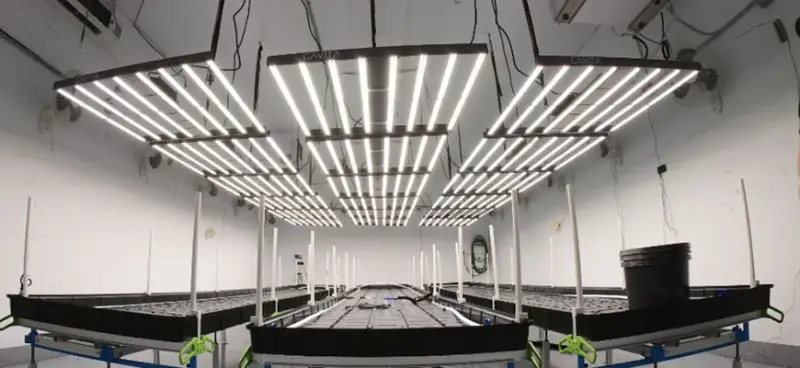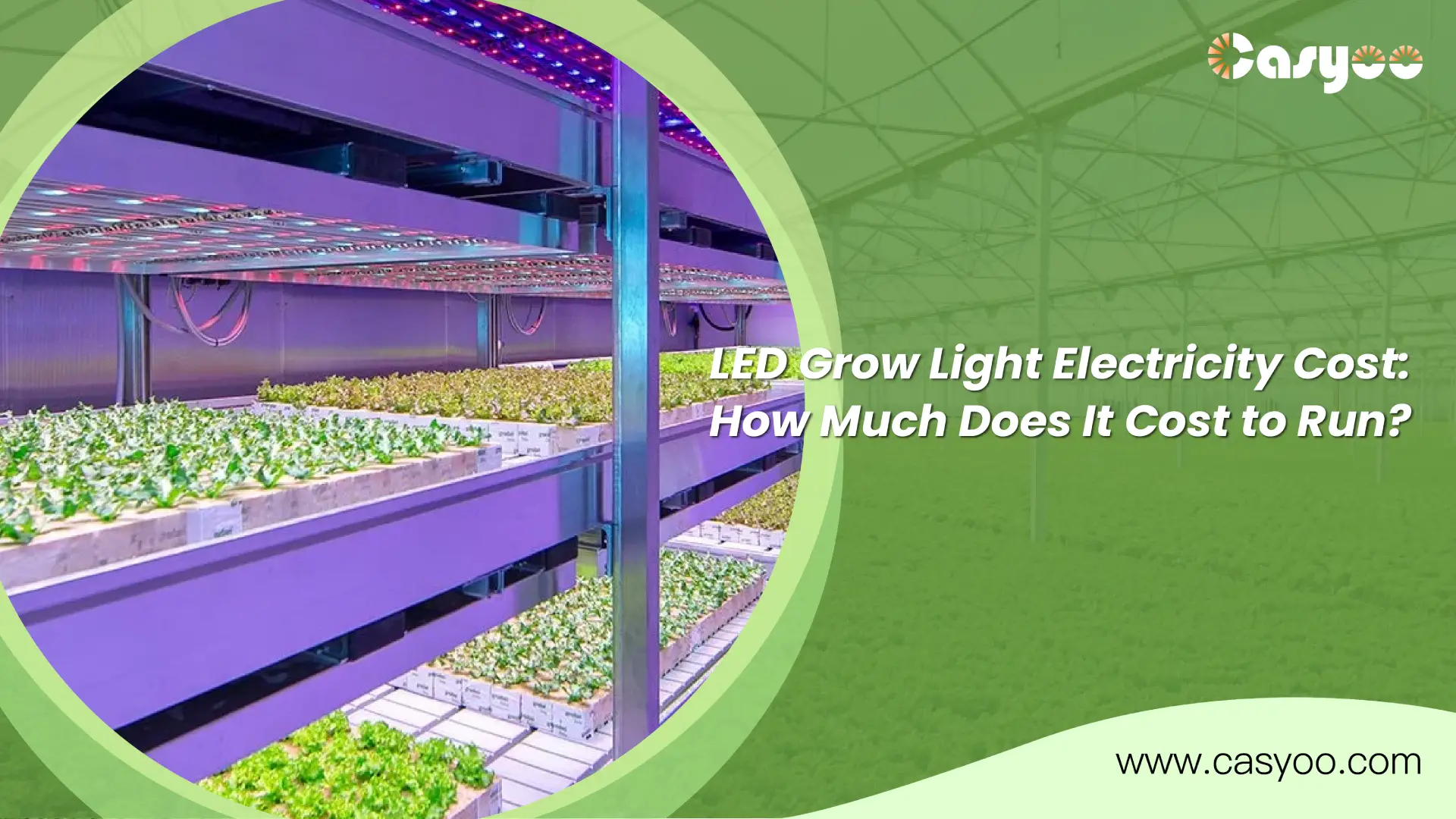As indoor gardening gains more and more attention, LED grow lights have become a reliable option for offering adequate supplemental light for crops. But do grow lights use a lot of electricity? How much do grow lights cost to run? Understanding the electricity cost of LED grow lights is important for both indoor gardeners and commercial growers. In this blog, we will talk about how to calculate the LED grow light electricity cost.
Are LED grow lights the most energy-efficient option?

Before calculating the electricity costs of LED grow lights, you may wonder if LEDs are more energy efficient than other traditional grow lights, such as HPS lights. For those who have never used LED grow lights before, the cost savings advertised can seem too good to be true.
While it is more expensive to purchase LED grow lights, high-quality LED grow lights cost less in the long run than HPS lights. Compared to HPS, LEDs are very efficient, do not generate a lot of heat, and provide your crops with the wavelengths they need for healthy growth.
Most LEDs offer a PPE of 2.7-3.5μmol/J, while HPS lights of the same wattage only offer a PPE of 1.8 μmol/J. That is, LEDs of the same wattage give off stronger light than HPS, so you can save a lot of money on electricity costs. In addition, HVAC systems cost much less than HPS because LEDs emit much less heat. Therefore, you can enjoy better light penetration with LED grow lights while using up to 40% less energy.
Common grow light electricity cost comparison
Here is a list of common wattages and corresponding energy consumption for different types of grow light sources. Different types of grow lights are suited to different growth scenarios. Power output of traditional light systems remains restricted because they both generate heat and require energy consumption at higher levels. Operating with higher wattages increases both electricity expenses and reduces system performance. However, unlike traditional lights, LED lights maintain their high energy efficiency throughout high-power system applications.
| Light Type | Typical Wattage | Daily Use (hrs) | Monthly kWh | Monthly Cost ($0.15/kWh) | Usage Notes |
| LED (Modern Full-Spectrum) | 300W | 12 | 108 kWh | $16.20 | Covers ~2×4 ft, very efficient |
| HID – HPS (High Pressure Sodium) | 600W (Equivalent to 300W LED) | 12 | 216 kWh | $32.40 | Common in flowering stage |
| HID – MH (Metal Halide) | 400W (Equivalent to 200W LED) | 12 | 144 kWh | $21.60 | Used for vegetative growth |
| CFL (Compact Fluorescent) | 45W (Equivalent to 20W LED) | 16 | 21.6 kWh | $3.24 | Good for seedlings/small herbs |
| Fluorescent Tube (T5 Fixture) | 216W (Equivalent to 120W LED) | 14 | 90.7 kWh | $13.61 | 4-tube fixture, common for seedlings |
How to calculate the LED Grow Light Electricity Cost?
If you want to accurately estimate the average cost of LED grow lights, you need to know the following three pieces of information:
- The wattage of your LED grow light: Some grow lights have fairly low wattage and only use 20 watts. Others can easily consume up to 200 watts or more.
- How long the light is used each day: This may seem obvious, a grow light that is on for 6 hours per day will have twice the energy usage compared to that is on for 12 hours per day. During the vegetable period, you will be running the light for 18-24 hours per day, which will result in higher monthly costs than during the flowering stage, when you may only run it for 12 hours per day.
- Electricity prices in your area: Typically, there will be a fixed price for a kilowatt-hour. For example, in the United States, the average electricity price in May 2024 was about 16.43 cents per kWh.
You can do the calculation yourself, the formula is (power, watts/1000) x hours run x cost per kWh. Or you can use our grow room cost calculator to calculate your electric bill!

Once you have found the total wattage of your LED grow light, you can divide it by 1,000 to get the rate in kilowatts. You can then multiply those kilowatts by the number of hours you keep your LED grow light on to get kilowatt-hours (kWh) and multiply that by the electricity rates in your area to get your daily electricity cost.
For example: how much does a 400W grow light cost to run?
For example, if you use a 400W grow light and run it for 12 hours per day, your daily electricity usage is 4.8 kWh (400 watts x 12 hours = 4800 watt-hours / 1000 = 4.8 kWh)
Multiplying your daily electricity use by the number of days in the month will give you your monthly electricity usage. For instance, if you use 4.8kWh of power every day and there are 30 days in a month, you will use 144kWh of electricity in total (4.8 kWh x 30 days = 144 kWh).
The average cost of electricity in the U.S. in 2024 is about 16.43 cents per kWh, which works out to 4.8 kWh x $0.1643 = $0.79 per day, which is multiplied by 30 days to an average monthly cost of $23.7.
How to reduce your LED grow light electricity costs?

Run your lights during the cheapest times
Electricity costs vary throughout the day. It’s often cheaper to use electricity at night, or early in the morning. If that’s a possibility in your state/company, use your grow lights during cheaper times of the day. Your electricity costs will also vary depending on the season and where you choose to set up your grow room.
Choose an autoflowering strain
Pure strains of sativas generally require the most time and attention to grow—and therefore, they require more energy. In contrast, autoflowering strains take less time to reach full flowering.
Use more efficient grow lights
The best way to cut your grow room running costs is to use more efficient grow lights. LED grow lights have a higher initial cost, but actually pay for themselves over time. LEDs also provide more powerful light with a superior spectrum. Additionally, investing in an LED grow light with dimming and spectrum adjustment features gives you more control over light output and light quality.
Switch to a more affordable electricity company
If your country/state has multiple electricity suppliers, see which one is more affordable and make the switch.
Reduce the hours your grow lights run
Let’s say you’re growing Monstera and you run your grow lights for 16 hours. Maybe turning on the lights for only 12 hours is enough? Try it for a few months and see how your plant responds. Do the new leaves get bigger or smaller, and do they get more or less porous? If the leaves continue to grow larger and develop more porous, then reducing the light hours will most likely be fine. And it will also reduce your electricity costs.
Use natural light whenever possible
If the weather is nice and your plants are near a window, you may not need artificial grow lights. In this case, turn your grow lights off, even if only for a few hours. You can even use a timer to set them to turn on and off automatically.
Enjoy the best energy efficiency with Casyoo
Although most LED grow lights have low energy costs, high-quality grow lights have better energy costs. It is important to purchase grow lights from reliable grow light manufacturers, which generally have dimmable functions, full-spectrum Samsung diodes, and daisy chain accessories to further improve energy efficiency and reduce costs. You can trust Casyoo, contact us now!




